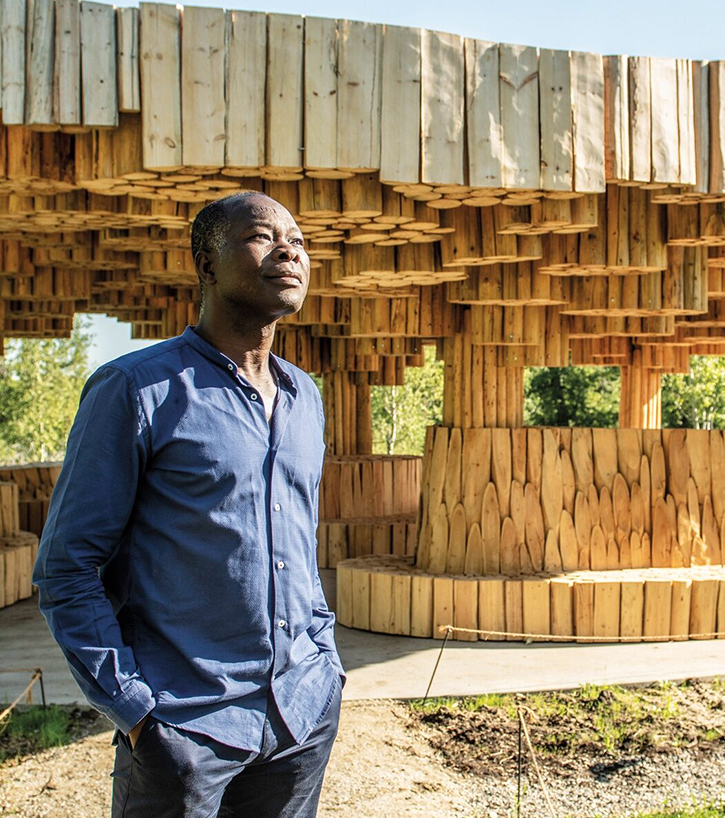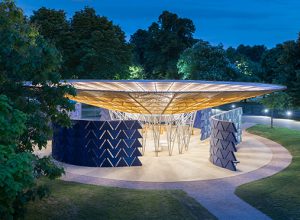Architecture and Design News | May 2022
By Norman Weinstein
February 2020 12:45 GMT

Francis Kere
 image courtesy: https://galeriemagazine.com/francis-kere-pritzker-prize/
image courtesy: https://galeriemagazine.com/francis-kere-pritzker-prize/
Francis Kere has been named the Laureate of the 2022 Pritzker Prize. He was born in the village of Gando in Burkina Faso, where he received his “first sense of architecture.” His architecture is characterized by a “democratic intention” towards users, or in his own words “everyone deserves quality, everyone deserves luxury, and everyone deserves comfort.” In this line of thought, it also means that everyone, rich or poor, needs to share the same conditions that command architecture today, such as climate change or scarcity of resources – Galeriemagazine
kecho.Kecho Collective had made to a finalist in Tactical Urbanism Now competition 2021.
ad hoc architecture. The iUrbanism of Los Angeles on Places Journal.
ecology | architecture & environment. Ecology and Design: Parallel Genealogies by Chris Reed & Nina-Marie Lister on Places Journal.
sustainability. What we don’t see on Places Journal
landscape. From Architecture to Landsacpe by Brian Davis & Thomas Oles on Places Journal.
Timeline

Kecho Journal | Archive
Kecho.News
TACTICAL URBANISM COMPETITION
Kecho Collective had made to a finalist in Tactical Urbanism Now competition 2021. In the context of Hanoi, tactical interventions are mostly led by citizens themselves as a response to ineffective top-down planning methodologies. Although effective in short-term, they lack supports from both authority and designers in order to stimulate long-term changes. If spontaneous interventions are synchronized with well-intended Tactical Urbanism projects, then good interventions can be scalable to catalyze long-term improvement of public spaces – Terravivacompetitions
Architect: Francis Kere
Francis Kere has been named the Laureate of the 2022 Pritzker Prize. He was born in the village of Gando in Burkina Faso, where he received his “first sense of architecture.” His architecture is characterized by a “democratic intention” towards users, or in his own words “everyone deserves quality, everyone deserves luxury, and everyone deserves comfort.” In this line of thought, it also means that everyone, rich or poor, needs to share the same conditions that command architecture today, such as climate change or scarcity of resources – Galeriemagazine
Typology
The MFAH’s program includes 240,000 sf structure that hosts permanent collection of modern and contemporary art. The building is a synthesis of Holl’s revisited program and the trapezoidal site of the Museum District. Porisity and light continue to be the central theme for Steven Holl in this building, emphasized by the use of translucent glass tubes for cladding. The assembly could reduce cooling requirements by 40 percents, according to Kendall/ Heaton Associates. While the exterior pays tribute to Mies, the interior natural lighting is inspired by Louis Kahn’s Kimbell Art Museum, but “more organic, more dynamic – like the clouds.” Architectural Records
City Architecture
HANOI HERITAGE: FRENCH VILLA
ad hoc architecture.
The iUrbanism of Los Angeles in an essay by Joe Day on Informal Urbanism and the relevant tendencies among contemporary architects and designers. One of the arguments is that architects should design around users’ life rather than dictating their ideologies. iUrbanism seems to be the logical evolution of “the Everyday” in urbanism practices. Whatever the names, these approaches aim to function at different scales, and “more grounded and street level.” The urban practices can be documented in strategies such as Mimi Zeiger’s “The Interventionist’s Toolkit,” where she explores the tactics of “guerilla urbanism,” often characterized by ubiquitous and opportunistic qualities. – Places Journal
ecology | architecture & environment.
Ecology and Design: Parallel Genealogies by Chris Reed & Nina-Marie Lister. The author first aknowledges the contemporary role of ecology in landscape architecture as ” a construct for managing change, and as a model of cultural production or design.” – Places Journal
sustainability.
Landscape.
From Architecture to Landsacpe by Brian Davis & Thomas Oles on Places Journal. This article positions landscape as an inherently multidisciplinary profession, as it mediates the boudaries of different fields. The term ‘Landscape Architecture’ is therefore problematic. The authors trace back the origin of this coinage from the time of John Claudius Loudon (1840) in England to Humphry Repton in the United States, to Andrwew Jackson Downing, whose work (Treatise on the Theory and Practice of Landscape Gardening – 1841) synthesizing the philosophies on landscape of these two practitioners. On all account, these practitioners thought of landscape as and “adjacency” of architecture. The famous landscape architect Frederick Law Omlsted himself had another reason to associate the two terms. He thought of an alternative for the service of landscape gardener, whose services held much less valuable than that of the architecture profession, or in his own words: “Like medieval traders setting up camp outside the city wall, landscape architects needed to stake out a space for their craft in the protective shadow of an older, established one.” The authors propose for an “upgrade” of Olmsted terms for Landscape Architecture as “Landscape Science.” The begin with the definition of science by Karl Marx and stress the importance of investigating the difference between “appearance” and “essence” in landscape. Landscape science, they argue, ought to be a normative science, which is considered by Charles Sanders Peirce as a science that “investigates the relations between empirical relation and ends,” and that “distinguishes what ought to be from what ought not to be.” To conclude, the authors emphasize that “the metaphor of landscape-as-architecture is historical, not ontological,” and that it can be remade to meet contemporary demands. A new landscape science would pose significant changes both in education and practice, in which the latter would give space for other “collaborators in the process of making” like users, maintenance workers or even bluebirds. – Places Journal
Design Magazines
AA School
The AA Archive holds a large collection of recordings of lectures,conferences, symposia and other public programme events presented at the AA. Dating back to 1968, the collection includes titles by leading architects, artists, historians, and theorists of the last 50 years including Cedric Price, Reyner Banham, Kenneth Frampton, Peter Cook, Rem Koolhaas and Zaha Hadid.
Arch News Now featuring news from other magazines, including latest debates on the profession, projects and competitions. It also has its own op/ed section.
Architects Journal featuring Building Studies, Specifications, Practice, Podcasts, Film, Magazines, Library and Events.
Architectural Record features Houses, Building Types, Interviews, Book Reviews and Podcasts.
Art News: on architects to “draw the line on designing jails [and such] until America repairs racial injustice,” and “shift their efforts towards ‘supporting the creation of new systems, processes, and typologies'” (it’s not a ban on designing justice facilities).
Designboom: on architects to “draw the line on designing jails [and such] until America repairs racial injustice,” and “shift their efforts towards ‘supporting the creation of new systems, processes, and typologies'” (it’s not a ban on designing justice facilities).
DETAIL: Topics include Sustainability, Researches on Components & Material, Energy & Resources, as well Structure.
Dezeen: on architects to “draw the line on designing jails [and such] until America repairs racial injustice,” and “shift their efforts towards ‘supporting the creation of new systems, processes, and typologies'” (it’s not a ban on designing justice facilities).
Divisare: on architects to “draw the line on designing jails [and such] until America repairs racial injustice,” and “shift their efforts towards ‘supporting the creation of new systems, processes, and typologies'” (it’s not a ban on designing justice facilities).
Domus: on architects to “draw the line on designing jails [and such] until America repairs racial injustice,” and “shift their efforts towards ‘supporting the creation of new systems, processes, and typologies'” (it’s not a ban on designing justice facilities).
Dwell: Photo section dwells on rooms and components: kitchen, bath, bedroom. living, dining, outdoor, kids, office, exterior, storage, doors, windows, staircase, laundry, hallway, garage, shed & studio. The Home Tours section includes Tiny Home, Prefab and Renovations projects.
FORM: on architects to “draw the line on designing jails [and such] until America repairs racial injustice,” and “shift their efforts towards ‘supporting the creation of new systems, processes, and typologies'” (it’s not a ban on designing justice facilities).
Frame: focuses on interior design across typologies: Retail, Hospitality, Work, Institutions, Residences and Shows.
Havard Design Magazine: on architects to “draw the line on designing jails [and such] until America repairs racial injustice,” and “shift their efforts towards ‘supporting the creation of new systems, processes, and typologies'” (it’s not a ban on designing justice facilities).
Inhabitat: on architects to “draw the line on designing jails [and such] until America repairs racial injustice,” and “shift their efforts towards ‘supporting the creation of new systems, processes, and typologies'” (it’s not a ban on designing justice facilities).
Juxtapoz: on architects to “draw the line on designing jails [and such] until America repairs racial injustice,” and “shift their efforts towards ‘supporting the creation of new systems, processes, and typologies'” (it’s not a ban on designing justice facilities).
l’Architecture d’Aujourd’hui: on architects to “draw the line on designing jails [and such] until America repairs racial injustice,” and “shift their efforts towards ‘supporting the creation of new systems, processes, and typologies'” (it’s not a ban on designing justice facilities).
Metropolis: on architects to “draw the line on designing jails [and such] until America repairs racial injustice,” and “shift their efforts towards ‘supporting the creation of new systems, processes, and typologies'” (it’s not a ban on designing justice facilities).
Places Journal: on architects to “draw the line on designing jails [and such] until America repairs racial injustice,” and “shift their efforts towards ‘supporting the creation of new systems, processes, and typologies'” (it’s not a ban on designing justice facilities).
Tạp chí Kiến Trúc: on architects to “draw the line on designing jails [and such] until America repairs racial injustice,” and “shift their efforts towards ‘supporting the creation of new systems, processes, and typologies'” (it’s not a ban on designing justice facilities).
The Architects Newspaper: on architects to “draw the line on designing jails [and such] until America repairs racial injustice,” and “shift their efforts towards ‘supporting the creation of new systems, processes, and typologies'” (it’s not a ban on designing justice facilities).
The Art Newspaper: on architects to “draw the line on designing jails [and such] until America repairs racial injustice,” and “shift their efforts towards ‘supporting the creation of new systems, processes, and typologies'” (it’s not a ban on designing justice facilities).
The Guardian: on architects to “draw the line on designing jails [and such] until America repairs racial injustice,” and “shift their efforts towards ‘supporting the creation of new systems, processes, and typologies'” (it’s not a ban on designing justice facilities).
Uncube: on architects to “draw the line on designing jails [and such] until America repairs racial injustice,” and “shift their efforts towards ‘supporting the creation of new systems, processes, and typologies'” (it’s not a ban on designing justice facilities).
Zinio: on architects to “draw the line on designing jails [and such] until America repairs racial injustice,” and “shift their efforts towards ‘supporting the creation of new systems, processes, and typologies'” (it’s not a ban on designing justice facilities).

